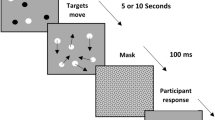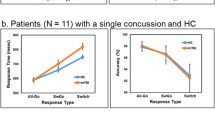Abstract
Using a classical psychological refractory period (PRP) paradigm we investigated whether increased interference between dual-task input processes is one possible source of dual-task deficits in patients with closed-head injury (CHI). Patients and age-matched controls were asked to give speeded motor reactions to an auditory and a visual stimulus. The perceptual difficulty of the visual stimulus was manipulated by varying its intensity. The results of Experiment 1 showed that CHI patients suffer from increased interference between dual-task input processes, which is related to the salience of the visual stimulus. A second experiment indicated that this input interference may be specific to brain damage following CHI. It is not evident in other groups of neurological patients like Parkinson’s disease patients. We conclude that the non-interfering processing of input stages in dual-tasks requires cognitive control. A decline in the control of input processes should be considered as one source of dual-task deficits in CHI patients.




Similar content being viewed by others
References
Arnell K, Jolicoeur P (1999) The attentional blink across stimulus modalities: evidence for central processing limitations. J Exp Psychol Hum Percept Perform 25:630–648
Azouvi P, Jokic C, Van Der Linden M, Marlier N, Bussel B (1996) Working memory and supervisory control after severe closed-head injury. A study of dual task performance and random generation. J Clin Exp Neuropsychol 18:317–337
Benecke R, Rothwell JC, Dick JPR, Day BL, Marsden CD (1986) Performance of simultaneous movements in patients with Parkinson’s disease. Brain 109:739–757
Brass M, Derrfuss J, Matthes-von Cramon G, von Cramon DY (2003) Imitative response tendencies in patients with frontal lesions. Neuropsychology 17:265–271
Brown RG, Marsden CD (1990) Cognitive function in Parkinson’s disease: from description to theory. Trends Neurosci 13:21–29
Dalrymple-Alford JC, Kalders AS, Jones RD, Watson RW (1994) A central executive deficit in patients with Parkinson’s disease. J Neurol Neurosurg Psychiatry 57:360–367
De Jong R (1993) Multiple bottlenecks in overlapping task performance. J Exp Psychol Hum Percept Perform 19:965–980
Dell’Acqua R, Stablum F, Galbiati S, Spannocchi G, Cerri C (2001) Selective effect of closed-head injury on central resource allocation: evidence from dual-task performance. Exp Brain Res 136:364–378
Dell’Acqua R, Pashler H, Stablum, F (2003a) Multi-tasking costs in CHI-patients: a fine-grained analysis. Exp Brain Res 152:29–41
Dell’Acqua R, Jolicoeur P, Pesciarelli F, Job R, Palomba D (2003b) Electrophysiological evidence of visual encoding deficits in a cross-modal attentional blink paradigm. Psychophysiology 40:629–639
Donk M, Theeuwes J (2001) Visual marking beside the mark: prioritizing selection by abrupt onsets. Percept Psychophys 63:891–900
Fahn S, Elton RL [members of the UPDRS Development Committee] (1987) The unified Parkinson’s disease rating scale (UPDRS). In: Fahn S, Marsden CD, Calne DB, Goldstein M (eds) Recent developments in Parkinson’s disease, vol 2. Macmillan, Florham Park NJ, pp 293–304
Folstein MF, Folstein SE, McHugh PR (1975) “Mini-Mental-State”: a practical method for grading the cognitive state of patients for the clinician. J Psychiatr Res 12:189–198
Fournet N, Moreaud O, Roulin JL, Naegele B, Pellat J (1996) Working memory in medicated patients with Parkinson’s disease: the central executive seems to work. J Neurol Neurosurg Psychiatry 60:313–317
Gellatly A, Cole G, Blurton A (1999) Do equiluminant object onsets capture visual attention? J Exp Psychol Hum Percept Perform 25:1609–1624
Hein G, Schubert T (2004) Aging and input processing in dual-task situations. Psychol Aging (in press)
Hoehn MM, Yahr MD (1967) Parkinsonism: onset, progression, and mortality. Neurology 17:427–442
Horstink MW, Berger HJ, Van Spaendonck KP, Van-den-Bercken JH, Cools AR (1990) Bimanual simultaneous motor performance and impaired ability to shift attention in Parkinson’s disease. J Neurol Neurosurg Psychiatry 53:685–690
Hsieh S (2000) The psychological refractory period in Parkinson’s disease. Percept Mot Skills 91:893–902
Jahanshahi M, Dirnberger G, Fuller R, Frith, CD (2000) The role of the dorsolateral prefrontal cortex in random number generation: a study with positron emission tomography. Neuroimage 12:713–725
Jolicoeur P (1999) Restricted attentional capacity between sensory modalities. Psychon Bull Rev 6:87–92
Kaipio ML, Alho K, Winkler I, Escera C, Surma-aho O, Näätänen R (1999) Event-related brain potentials reveal covert distractibility in closed head injury. Neuroreport 10:2125–2129
Kaipio ML, Cheour M, Ceponiene R, Öhman J, Alku P, Näätänen R (2000) Increased distractibility in closed head injury as revealed by event-related potentials. Neuroreport 11:1463–1468
Kim MS, Cave KR (1999) Top-down and bottom-up attentional control: on the nature of interference from a salient distractor. Percept Psychophys 61:1009–1023
Knight RT, Staines WR, Swick D, Chao LL (1999) Prefrontal cortex regulates inhibition and excitation in distributed neural networks. Acta Psychol 101:156–178
Konishi S, Nakajima K, Uchida I, Kikyo H, Kameyama M, Miyashita Y (1999) Common inhibitory mechanism in human inferior prefrontal cortex revealed by event-related functional MRI. Brain 122:981–991
Leclercq M, Couillet J, Azouvi P, Marlier N, Martin Y, Strypstein E, Rousseaux M (2000) Dual task performance after severe diffuse traumatic brain injury or vascular prefrontal damage. J Clin Exp Neuropsychol 22: 339–350
Lewis SJG, Cools R, Robbins TW, Dove A, Barker RA, Owen AM (2003) Using executive heterogeneity to explore the nature of working memory deficits in Parkinson’s Disease. Neuropsychologia 41:645–654
Luck SJ (1998) Sources of dual-task interference: evidence from human electrophysiology. Psychol Sci 9:223–227
Malapani C, Pillon B, Dubois B, Agid Y (1994) Impaired simultaneous cognitive task performance in Parkinson’s disease: a dopamine-related dysfunction. Neurology 44:319–326
McCann RS, Johnston JC (1992) Locus of the single-channel bottleneck in dual task interference. J Exp Psychol Hum Percept Perform18:471–484
McDowell S, Whyte J, D’Esposito M (1997) Working memory impairments in traumatic brain injury: evidence from a dual-task paradigm. Neuropsychologia 35:1341–1353
Meyer DE, Kieras DE (1997) A computational theory of executive cognitive processes and multiple-task performance. Part 1. Basic mechanisms. Psychol Rev 104:3–65
Miller J (1989) The control of attention by abrupt visual onsets and offsets. Percept Psychophys 45:567–571
Park NW, Moscovitch M, Robertson IH (1999) Divided attention impairment after traumatic brain injury. Neuropsychologia 37:1119–1133
Pashler H (1994) Dual-task interference in simple tasks: data and theory. Psychol Bull 116:220–224
Pashler H, Johnston JC (1989) Chronometric evidence for central postponement in temporally overlapping tasks. Q J Exp Psychol 41A:19–45
Pollux PM, Robertson C (2002) Reduced task-set inertia in Parkinson’s disease. J Clin Exp Neuropsychol 24:1046–1056
Polo MD, Newton P, Rogers D, Escera C, Butler S (2002) ERPs and behavioral indices of long-term preattentive and attentive deficits after closed head injury. Neuropsychologia 40:2350–2359
Richardson JTE (2000) Clinical and neuropsychological aspects of closed head injury. Psychology Press, Philadelphia
Robertson C, Hazlewood R, Rawson MD (1996) The effects of Parkinson’s disease on the capacity to generate information randomly. Neuropsychologia 34:1069–1078
Saint-Cyr J, Hoque T, Pereira LC, Dostrovsky JO et al. (2002) Localization of clinically effective electrodes in the human subthalamic nucleus on magentic resonance imaging. J Neurosurg 97:1152–1166
Schubert T (1999) Processing differences between simple and choice reactions affect bottleneck localization in overlapping tasks. J Exp Psychol Hum Percept Perform 25:1–18
Schubert T, Szameitat AJ (2003) Functional neuroanatomy of interference in overlapping dual tasks: an fMRI study. Cogn Brain Res 17:733–746
Schweickert R (1983) Latent network theory: Scheduling of processes in sentence verification and the Stroop effect. J Exp Psychol Learn Mem Cogn 9:353–379
Solbakk AK, Reinvang I, Nielsen C, Sundet K (1999) ERP indicators of disturbed attention in mild closed head injury: a frontal lobe syndrome? Psychophysiology 36:802–817
Stablum F, Leonardi G, Mazzoldi M, Umiltà C, Morra S (1994) Attention and control deficits following closed head injury. Cortex 30:603–618
Szameitat AJ, Schubert T, Mueller K, von Cramon DY (2002) Localization of executive functions in dual-task performance with fMRI. J Cogn Neurosci 14:1184–1199
Theeuwes J (1991) Exogenous and endogenous control of attention: the effect of visual onsets and offsets. Percept Psychophys 49:83–90
Theewes J (1994) Endogenous and exogenous control of visual selection. Perception 23:429–440
Werheid K, Hoppe C, Thoene A, Mueller U, Muengersdorf M, von Cramon DY (2002) The Adaptive Digit Ordering Test. Clinical application, reliability, and validity of a verbal working memory test. Arch Clin Neuropsychol 17:547–65
Whyte J, Schuster K, Polansky M, Adams J, Coslett HB (2000) Frequency and duration of inattentive behavior after traumatic brain injury: effects of distraction, task, and practice. J Int Neuropsychol Soc 6:1–11
Wrightson P, Gronwall D (1999) Mild head injury. A guide to management. Oxford University Press, New York
Yantis S (1993) Stimulus-driven attentional capture and attentional control settings. J Exp Psychol Hum Percept Perform 19:676–681
Yantis S, Johnson DN (1990) Mechanisms of attentional priority. J Exp Psychol Hum Percept Perform 16:812–825
Acknowledgements
The research was supported by the Bundesministerium für Bildung und Forschung (BMB+F), Interdisciplinary Center for Clinical Research (IZKF) at the University of Leipzig (01KS9504, project C09). Many thanks go to Katja Werheid for help in recruiting and testing of the PD patients. We also thank Mike Reuter, Martina Muengersdorf, Antje Mueller and Michael Joebges for the neurological assessment of the PD group. Further, we thank Corinna Kossack for help in recruiting the CHI patients and Franziska Korb and Tina Jentzsch for help in data collection.
Author information
Authors and Affiliations
Corresponding author
Additional information
The reported experiments are part of the doctoral dissertation by Grit Hein, which was conducted at the Department of Cognitive Neurology, University of Leipzig, and supervised by T.S.
Rights and permissions
About this article
Cite this article
Hein, G., Schubert, T. & von Cramon, D.Y. Closed head injury and perceptual processing in dual-task situations. Exp Brain Res 160, 223–234 (2005). https://doi.org/10.1007/s00221-004-2006-y
Received:
Accepted:
Published:
Issue Date:
DOI: https://doi.org/10.1007/s00221-004-2006-y




